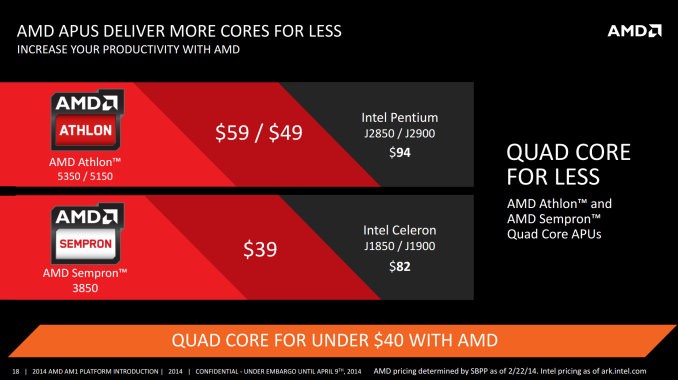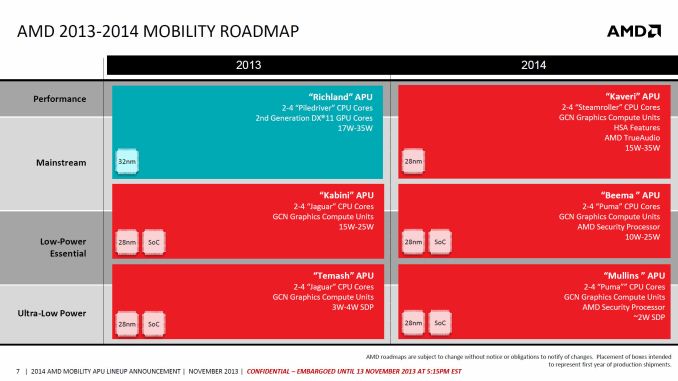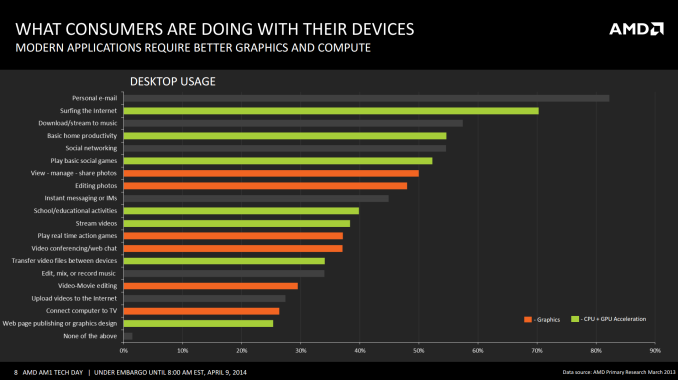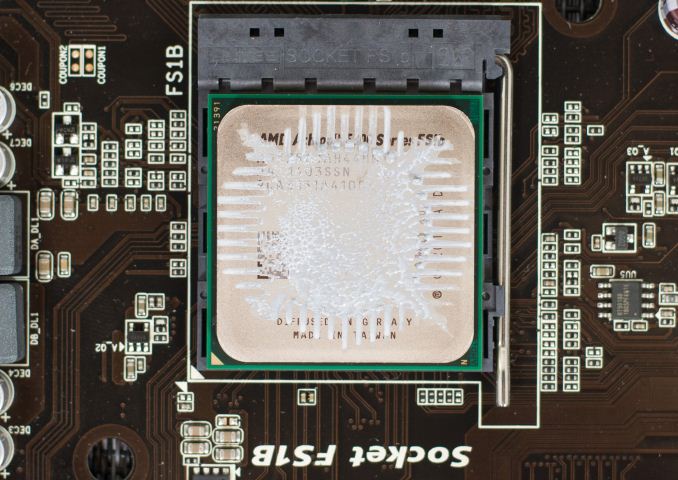The Desktop Kabini Review Part 1: AMD Athlon 5350 (AM1) Tested
by Ian Cutress on April 9, 2014 8:00 AM ESTFinal Words
As mentioned in our test setup, the benchmark results in this preliminary article are only a small fraction of our normal coverage. Due to other commitments we were unable to run every test on all comparison systems, but we have the other Athlon and Sempron APUs as well as comparable Intel counterparts coming in for review.
The poignant place to start with the final analysis is AMD’s claim of ‘Quad Core for Less’. In this statement alone, they are not wrong. Intel cannot provide a socketed quad core processor for less than $36 (Sempron 3850). The cheapest all-in-one desktop quad-core system from Intel equips the Celeron J1900 onto a motherboard for $92, which is exactly where AMD sit with the top-end Kabini based Athlon 5350 with a motherboard. One of the issues to consider at this point however is that Intel offers several dual core options (non-Atom) around this $40-$60 price point, and in many cases the IPC and CPU speed advantage of these cores is greater than that provided by Kabini, particularly in single threaded applications. The only downsides to this solution are the power consumption is higher, and the motherboards are more expensive. For a competitive socketed Intel dual core, a motherboard plus CPU can be in the region of $110-$120 at 35W-55W.
The big upside and selling point from the AM1 Kabini platform should be upgradeability. If a user buys an AM1 platform now, they should be able to upgrade it in the future. While AMD has not yet confirmed if Beema is coming to the socketed platform, the roadmaps suggest that the laptop sockets are remaining consistent from Kabini to Beema. This should imply that if Beema gets a socketed version, it should also remain based on AM1/FS1b.
If we compare single threaded performance between Kabini and our J1800 test system, the benchmarks are almost even between the two, particularly when it comes to synthetics such as Cinebench, but falls behind on emulation such as the Dolphin Benchmark and 3DPM. The integrated graphics of the Kabini pull ahead when it comes to gaming, despite the single channel memory interface.
|
AMD Athlon 5350 vs. Intel Celeron J1800 Single Threaded |
||
| Athlon 5350 | Celeron J1800 | |
| Cinebench R10 | 1967 | 1917 |
| Cinebench R11.5 | 0.51 | 0.49 |
| Dolphin Benchmark | 40.4 | 38.02 |
| 3DPM | 53.29 | 69.20 |
When placing Kabini against any Intel Ivy Bridge socketed processor, the increased IPC and frequency pushes the system above the Kabini, in exchange for more power and a more expensive system overall. If we compare the Kabini single-threaded results to those of the Celeron G465, a Sandy Bridge based single core CPU at 1.9 GHz, the Celeron does pull ahead on the majority, but fails miserably in the graphical benchmark suite.
|
AMD Athlon 5350 vs. Intel Celeron G465 Single Threaded |
||
| Athlon 5350 | Celeron G465 | |
| Cinebench R10 | 1967 | 2975 |
| Cinebench R11.5 | 0.51 | 0.73 |
| Dolphin Benchmark | 40.4 | 38.8 |
| 3DPM | 53.29 | 59.98 |
Does it seem particularly odd that a modern Kabini architecture at 2 GHz cannot keep up with a 3 year old Sandy Bridge processor at 1.9 GHz at our simple benchmarks? AMD is leveraging on the fact that much of what we do on a computer as a casual user can leverage the fixed function units of the graphics center of the APU:
AMD’s key in all of this is leveraging the GPU. For non-GPU intensive tasks, on paper, the J1900 for $92 and 10W TDP would seem to be the choice if upgradability is not a concern. The remit of AM1 and Kabini could be extended if motherboard manufacturers decided to use those extra PCIe lanes. Consider an AM1 with controllers to make a nice routing system (4x NIC) or something based around storage (SATA controllers and hubs). But because Kabini is also a cost play for AMD at the low-end desktop segment, margins are going to be ultra-tight for motherboard manufacturers and I do not imagine that as much effort will be put into making innovative products as the rest of their product range on other sockets.
In order for the upgradability angle to work, AMD need to keep the sockets around for at least two generations. AM1 comes late in Kabini’s life cycle, given that Beema on the mobile side is due out later in 2014. It would make sense for AMD to release Beema desktop parts, but the big question there is when. AMD could launch new processors on day 1 of Beema, or further into the life cycle. I would imagine that depends on what the competition does. AMD does have that advantage of having an upgradeable platform before Intel; however Intel may see the market differently. It is a hard one to judge.
Stay tuned for our full benchmark suite on the other AMD Kabini APUs.














126 Comments
View All Comments
jabber - Wednesday, April 9, 2014 - link
Yep slap a 120GB SSD in there and you have a nice little office system for not a lot of outlay. Doesnt matter if its SATA2, its all in the access times.meacupla - Wednesday, April 9, 2014 - link
what would be nice is high bit rate software 1080p playback, for when DXVA doesn't work.I remember my E-350 getting choppy on those.
Medallish - Wednesday, April 9, 2014 - link
Well the one I built feels pretty responsive, even with a mechanical drive. You do need to install the drivers, but once they were on there it didn't feel at all sluggish, I tried loading up a bunch of heavily advertised pages on chrome, and didn't really notice any impact on performance. I must admit I haven't tried any 1080p Youtube videos, but I will give those a go, I imagine it runs fine, I had a Quad Core "Phenom II" Mobile CPU that ran 2GHz, performance should be pretty close to this I imagine. And yeah I did a test on that running a youtube video @ 1080p and a 1080p video on VLC at the same time, now this was running a 6670m which is bound to be a lot better than this, but the CPU wasn't holding it back atleast.gandergray - Wednesday, April 9, 2014 - link
Hello Ian. Thank you for the article. In the second to last sentence of the paragraph that follows the Athlon v. Celeron table in the “Competition” section, the word “subsiding” should be “subsidizing”.JDG1980 - Wednesday, April 9, 2014 - link
The Cinebench 10 benchmark indicates that Kabini's IPC is only slightly below that of Intel's old Conroe architecture (E2180, running at the same 2GHz clock speed). For such a small die and low TDP, that's actually pretty good. Integer IPC seems to be better than Intel's Baytrail series, though floating-point lags a bit (at least if 3D Particle Motion is a good test - never heard of it before).IPC for AMD's big cores is still not much better than Conroe, and lags behind Nehalem. Steamroller was supposed to help, but didn't do much for IPC (even though it did reduce the CMT penalty). This calls into question why AMD's 'construction equipment' cores are even still being developed. If the small 'cat' cores can do as well as they do with only a dual-issue front end, and a bunch of other missing optimizations (e.g. no decoded micro-op cache), then beefing up the basic design for desktop/server use would probably beat Steamroller in IPC while having lower power usage. It wouldn't close the gap with Intel's big cores, but it would at least provide a solid foundation to build on. This would be the same thing Intel did themselves back when they ditched the unviable Netburst design in favor of one derived from the mobile Pentium-M.
mrdude - Wednesday, April 9, 2014 - link
Yea, I think many people would agree with you. I like the Jaguar architecture quite a bit, as it seems to be very well balanced. The 4-way shared L2 and integer performance seem like very solid foundations to build upon. The fact that it has AVX whereas Intel's Atoms and low end Celerons don't is also an awesome feature....but it has no turbo. AMD's turbo core is actually really advanced, dynamically adjusting clock speeds and voltages depending on the CPU or GPU load or both. Even the steaming pile of poo that was Bulldozer had a great turbo, but for some reason AMD decided not to dedicate the resources and engineering talent to fit Kabini with the same feature.
I'd love to see AMD dump the construction line and work on something similar to Jaguar that scales upward and wider more easily. It might not be a monster, but at least it offers decent perf-per-watt.
errorr - Wednesday, April 9, 2014 - link
Pretty sure the 3d particle motion test was written by Ian and I vaguely recall it being related to his PhD Thesis.lever_age - Wednesday, April 9, 2014 - link
Just a small suggestion, but for comparative performance tables like the one on the last page, could you mark benchmarks by whether a higher or lower number is better (like on the larger graphs)? I guess this could be done either in the margin by the benchmark name or by coloring the winning column.mr_tawan - Wednesday, April 9, 2014 - link
Looks a lot like P3 or Athlon board to me, especially when the cpu+cooler is installed. Feel nostalgic.errorr - Wednesday, April 9, 2014 - link
Well except the lack of North Bridge and no diarrhea brown AGP slot.